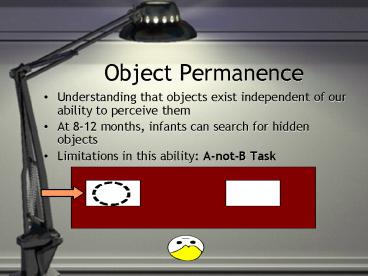Object Permanence - PowerPoint PPT Presentation
1 / 26
Title:
Object Permanence
Description:
Understanding that objects exist independent of our ability to ... Even infants as young as 20 days old see the bottom left alternative (no ball) as surprising ... – PowerPoint PPT presentation
Number of Views:375
Avg rating:3.0/5.0
Title: Object Permanence
1
Object Permanence
- Understanding that objects exist independent of
our ability to perceive them - At 8-12 months, infants can search for hidden
objects - Limitations in this ability A-not-B Task
2
Object Permanence
- Understanding that objects exist independent of
our ability to perceive them - At 8-12 months, infants can search for hidden
objects - Limitations in this ability A-not-B Task
3
Object Permanence
- Understanding that objects exist independent of
our ability to perceive them - At 8-12 months, infants can search for hidden
objects - Limitations in this ability A-not-B Task
4
Object Permanence
- Understanding that objects exist independent of
our ability to perceive them - At 8-12 months, infants can search for hidden
objects - Limitations in this ability A-not-B Task
5
12-18 months
- Trial-and-error experimentation of the world to
find new and different ways of acting on it. - Before this, the infant produces known actions
that will produce mostly known outcomes
6
12-18 months
- Here the infant produces new actions and observes
the effects - Can do the A-not-B task but only when object is
visibly displaced - Indicates that the spatial relation of objects
relative to other objects is represented and is
not related to their actions
7
(No Transcript)
8
Factors
- Revolve around issues of information-processing
- Visual Attention
- Perception
- Memory
- Perceptual-Action Coupling
9
Memory
- Diamond (1985)
- If no delay between hiding and allowing infant to
search, then infants search correctly - If impose a delay, then get errors of searching
at B - 2 sec at 7.5 months
- Increasing by approximately 2 sec each month
10
Memory
- Lesions to adults prefrontal cortex, an area
involved in working memory, results in poor
performance on A not B task - Butterworth (1977)
- Used transparent occluders
- Found infants still make error
- So, it is not just a memory issue
11
Attention
- Maybe they just are not paying attention where it
is hidden - Could affect ability to remember
- Horobin Acredolo (1986)
- 3 conditions to test for how attention might
relate to ability to search
12
Horobin Acredolo
- 1) Close Pair (15.25 cm)
- 2) Far Pair (45.75 cm)
- 3) Six Hole (A and B 45.75 cm apart, with 4 holes
in between)
13
Horobin Acredolo Results
14
Horobin Acredolo Results
15
Horobin Acredolo Results
16
Transparent Occluders
- Because infants were found to make errors with
these, memory was ruled out as sole source of
errors - Yates Bremner (1988) suggest perhaps it is due
to novelty of transparent occluders
17
Yates Bremner
- Compared familiarizing infants to the occluders
for 5-10 minutes to not familiarizing them - Found Familiarized - 10 made errors
Unfamiliarized - 40 made errors - So memory, or more likely attention-induced
memory issues, may play an important role in this
error
18
A not B Task Concerns
- There is concern that performance in A not B task
is strongly influenced by the development of
motor control - Younger infants have poorer motor control,
therefore make more errors - So use task that does not require motor response
- Purpose of Ahmed Ruffman (2000)
- Use violation of expectation paradigm
19
Other Work on Object Permanence
- Bower (1966, 1967, 1982)
- Even infants as young as 20 days old see the
bottom left alternative (no ball) as surprising
20
(No Transcript)
21
Object Permanence
- Baillargeon (1987)
- Found that not until 4.5 months of age (substage
3) did infants increase attention to the
impossible event
22
Object Permanence
- Physical Events
- Spelke et al. (1992)
- Not until infants are 4 months of age do they
look longer at the inconsistent result
23
Object Permanence
- Numerical Cognition
- Wynn (1992)
- Infants as young as 3 months will look longer
when the number of items does not match the total
of what they had previously seen - Concluded that infants do basic math
24
Ahmed Ruffman
- 3 tasks
- 1) Classic A not B task
- 2) A not B nonsearch task (using violation of
expectation) - 3) one location nonsearch task
25
Ahmed Ruffman
26
Ahmed Ruffman
- Found that infants looked longer at the
impossible appearance of toy at A after being
hidden at B - There was no affect of delay or age
- There was affect of age and delay on classic A
not B task - If infants did not have to search, they were
found to remember even after 15s delay where toy
had been hidden - Go back to possibility that get effects due to
attention wandering back to A































